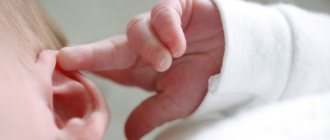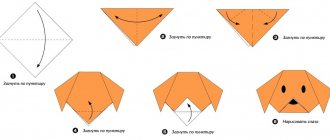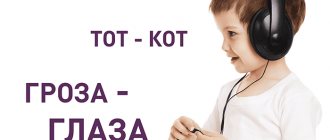What is phonemic awareness?
The auditory analyzer, the organ of hearing, which includes the ear, nerves and special centers in the cerebral cortex, is responsible for the ability to hear. It converts sound vibrations into nerve impulses, which are then transmitted to the central parts of the brain and cause certain human reactions. There are two types of hearing: physical and phonemic. The first determines the ability to perceive natural and household noise, as well as music.
Phonemic hearing allows you to hear and distinguish the sounds of human speech. Thanks to him, the child learns not only to understand speech and speak, but also to grasp the meaning of what is said, depending on the nature of the sounds (intonation, stress, endings, etc.). For example, hearing the difference between the similar “bear” and “bowl”, the mournful “oh” and the surprised one, the flowers “carnations” and daddy’s “carnations”.
Signs of violation
First of all, undeveloped phonemic hearing is indicated by a lack of understanding of the addressed speech, complete or partial. For example, if a child cannot complete simple tasks, he often asks questions or understands requests incorrectly. The second alarming sign is speech defects. The speech-auditory and speech-motor analyzers are closely related and have a significant influence on each other.
At 4 years old, a child normally speaks in phrases, uses prepositions, and is able to ask questions. By 5–6 years, all sounds except “R” are pronounced correctly, and endings are used correctly. In addition, a preschooler can easily name the first sound in a word and choose other words for it. There are 3 signs of phonemic hearing impairment (at 5 years):
- defects in sound pronunciation (for example, replacing hard sounds with soft ones);
- skipping sounds in words, rearranging them, using unnecessary sounds (fairy tale - sazka, umbrella - zotnik, butter - maslo);
- slight difference between similar sounds in oral speech and in writing s-sh, z-zh, d-t, etc. (zhuk - zuk, doctor - toctor, drying - shushka).
In schoolchildren, phonemic hearing disorders manifest themselves in slow reading and difficulty merging syllables. There are invariably errors in writing, the child hears incorrectly and writes the same way (double consonants, voiceless words at the end, unstressed vowels).
Development methods
It is possible to develop phonemic awareness only gradually. First, the child learns to recognize sounds that are not similar to each other, then learns about correct and incorrect pronunciation, and begins to find errors in familiar words. Next, the ability to conduct phonemic analysis, isolate sounds in parts of a word (beginning, middle, end), and select a rhyme is formed. At the final stage, already at school, the child can determine the quantitative sound composition of a word. He develops the ability to use test words and understand the rules.
The method of developing phonemic hearing is based on developing the ability to navigate the sound side of a word. Training is carried out in the form of a game and includes the following exercises:
- articulatory gymnastics aimed at improving the mobility of the tongue, lips, etc.;
- breathing exercises that allow you to correctly direct the air stream (for example, exercise “Candle”, “Feather”);
- education of intonation expressiveness of speech;
- developing the ability to control the power of the voice;
- classes on the correct pronunciation of all sounds;
- sound analysis of words (selection of similar and different-sounding words, identification of soft and hard sounds, ringing, murmuring, hissing, etc.);
- games with words (for example, choose a word that begins with a certain sound).
In this case, it is necessary to take into account the individual characteristics of the child, the upbringing environment, structural defects of the speech apparatus (short hyoid ligament, small and narrow tongue, open bite, etc.). Also, when developing phonemic hearing, one should take into account the sequence of distinguishing sounds - first vowels, then noisy and sonorant consonants, hard and soft, labial - lingual, deaf - voiced, hissing - whistling.
How to test phonemic awareness?
The easiest way is to consult a specialist. A speech therapist deals with issues of phonemic hearing impairment. The initial consultation is carried out at 3 years. At this age, it becomes clear whether the baby needs any help or whether development occurs according to age. At 5 years old, a child should already be able to clearly understand sounds and speak correctly (with the exception of the sound “r”). If this is not the case, special correction classes are needed.
Parents themselves can check their child’s phonemic hearing using a small test:
- Invite the child to choose a picture with a picture of a bear (they give two options, with a picture of a bear, and bowls - plates).
- Ask to stamp your foot when you hear the syllable sa. The adult says at the same pace: wa-ta-za-za-sa-ka-za.
- Ask your child what is the difference between cancer and varnish?
- Ask to come up with words for the vowel sounds “A”, “O”, “E”, “I”, “U”.










